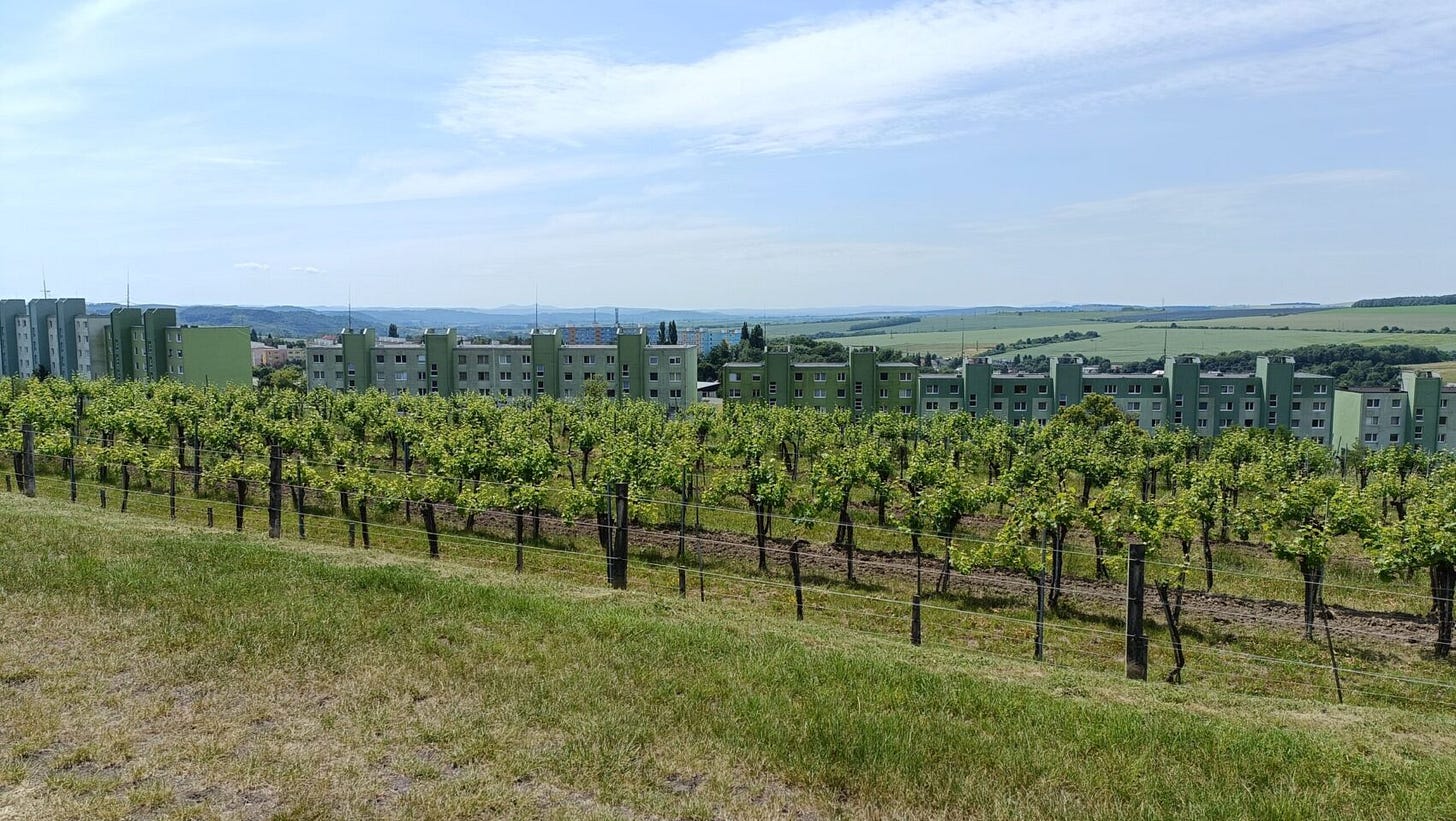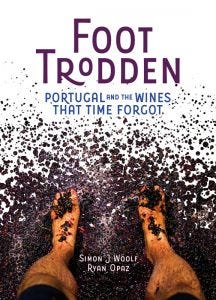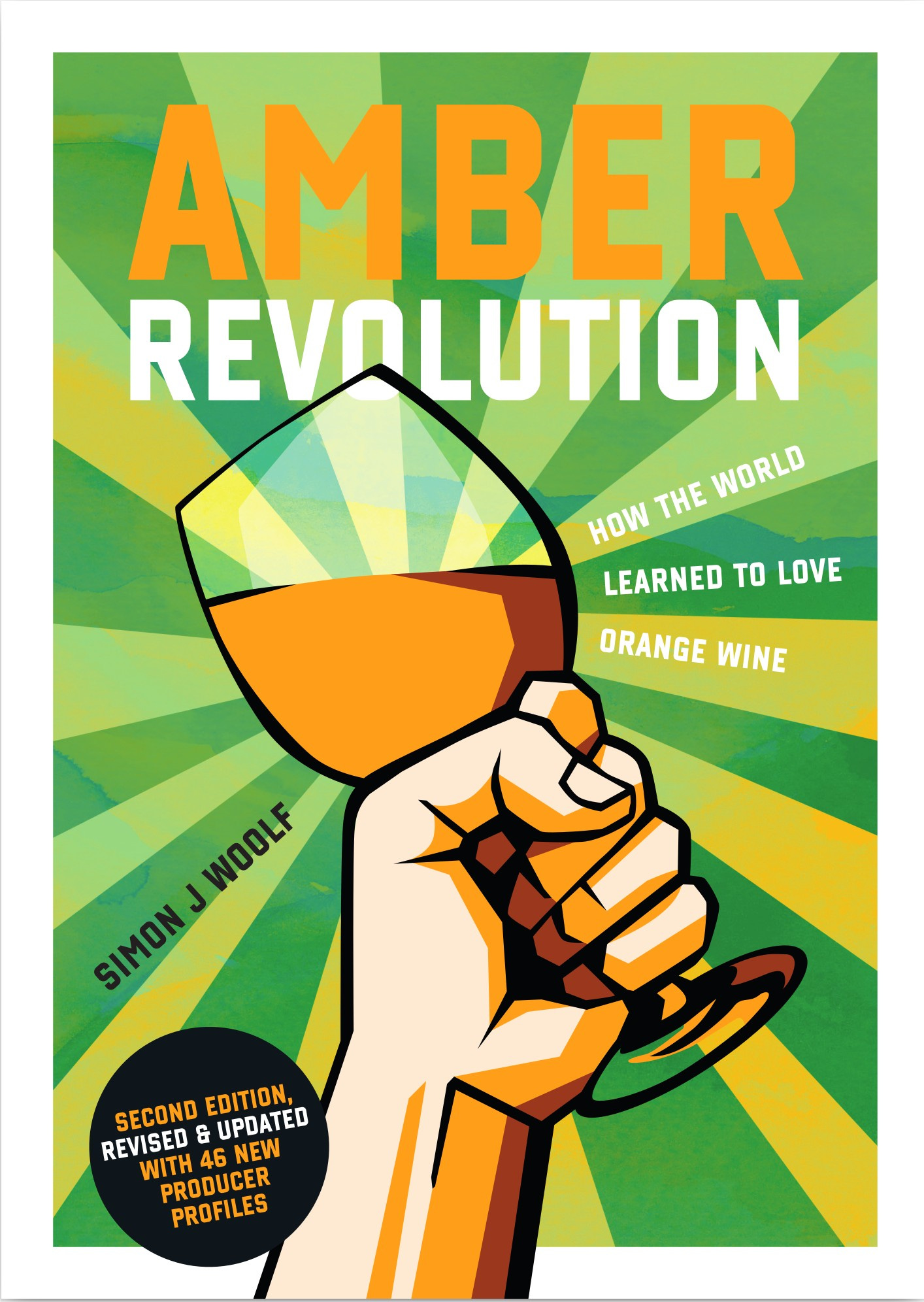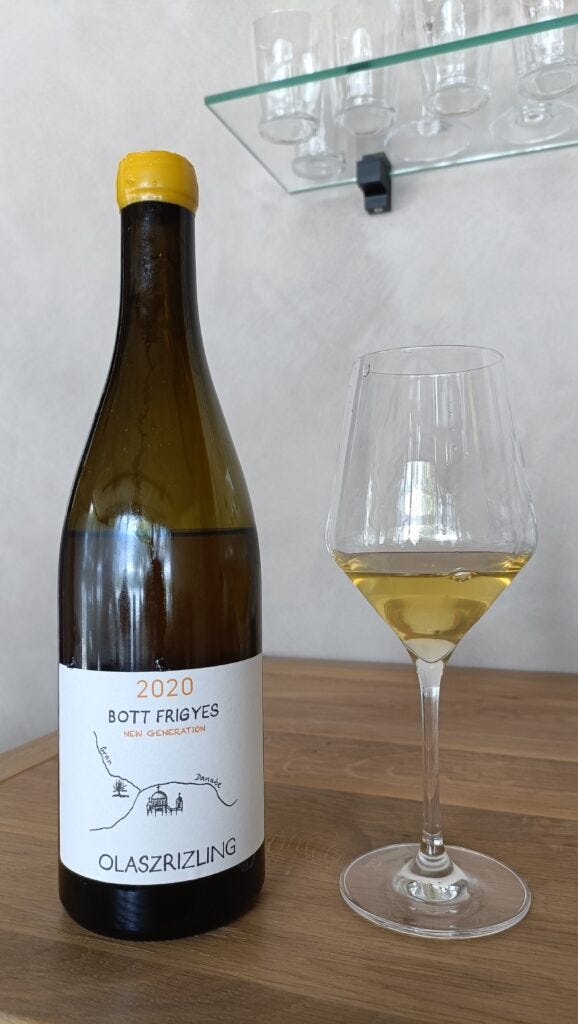My top 10 natural wine discoveries in 2022
Simon chooses 10 wines that surprised and delighted him in 2022.
It's popular at this time of year for wine and booze hacks to release their "top wines of 2022" selections. It is always interesting to see which kinds of wines appear in these lists. Most writers find it hard to resist inserting a few high status wines (top Bordeaux, Burgundy, Barolo, Napa or whatever), often priced at levels where it is pretty clear that said writer neither paid for the bottle nor could reasonably afford to do so.
There's nothing inherently wrong with this approach, but I think it lacks imagination. The risk of subjectivity becomes ever greater at ultra-premium prices. When the bottle of wine on the table cost €500, who wouldn't do their damnedest to have a bloody good time when they drink it?
A further issue is this: If I can't afford to buy a particular wine, it is difficult to recommend that bottle to the vast majority of readers and fellow wine lovers - most of whom will have budgetary constraints of some kind. That said, notions of affordability differ greatly from person to person. For most wine drinkers, €10 is already an expensive bottle. My own stance is that once the price gets into three figure territory (EUR), it starts to enter the label drinking zone where the name on the bottle has more influence over the price than the cost of production or even the scarcity. The exception here is old vintages. I have willingly paid much larger sums for wines which I considered to have historical as well as libatory interest.
Much harder, and more deserving of respect in my view, is the sourcing of extraordinary wines at prices that mere mortals can afford - at least as a treat. Plenty of these wines exist, you just need an open mind and willingness to experiment. In that spirit, here are some of my biggest surprises and most exciting new discoveries of 2022. Few of these selections are well known, and almost all were totally new to me this year. I don't wilfully seek out obscure wines (although they do seem to have a habit of finding me), but just enjoy the thrill of a new discovery perhaps from a country, region or grape variety that I had previously ignored. More than that, when something delicious hits my glass, there is a smile on my face and usually two simultaneous thoughts: 1) Where can I buy another bottle and 2) Who can I share this with? Here are ten wines that inspired this kind of reaction. They are presented in no particular order.
David Kušický - Seggs with My Eggs 2020 (Central Slovakia)
I first met David at this year's Karakterre, in Eisenstadt in May, and quickly tasted his wines. Entirely coincidentally, I then ran into him again in June at a visit to Domin & Kušický, his family's estate. This is a wine from his own line of natural wines. All the fruit comes from the family's organically certified vineyards. Perhaps David's garish, skate-graffiti style labels are not for everyone. Personally I love them, and they give a good idea of the nature of the contents: Youthful, fruity, nothing you need to take too seriously. Yet, at the same time, this doesn't quite give them the credit they deserve. Kušický is the third generation in his family to continue his grandfather's pioneering organic vineyard project in the ex-mining village of Veľký Krtíš, in central Slovakia, and he is shaping up to be a brilliant winemaker. Seggs with My Eggs is Viognier fermented in concrete eggs, and it is gorgeously chalky and smooth textured, with a salty, mineral lift. The area's volcanic soils have left their mark. The ripe pear fruit leaves you in no doubt as to the variety, but there is nothing heavy or oily here. Made with no additions and no added sulphites, it's thrillingly clean and stable and dangerously drinkable. Chapeau! Price and availability: €16 - €21 from various stockists in eastern Europe or Belgium. I'm sure this will be coming to more European locations soon.
Pivnica Brhlovce - Grüner Veltliner Nobl Sentiment 2020 (Central Slovakia)
More from my Slovakian adventures this summer. This is from the tiny village of Brhlovce, also in the volcanic region around Sitno. The village is famous for its cave dwellings - small houses built into the tuffeau. In the past, winemaking was common here, but it has all but died out post-communism. Ján Záborský downsized from a city job to move here and start making wine. He buys grapes from the local cooperative, more or less having the pick of the best fruit since he is the only producer in the village who bottles and sells wine commercially. I adored this fresh and slightly minty Grüner, which again shows a kind of mineral, volcanic energy. It's slightly salty, very taut and zippy without seeming thin or sour. Both energetic and refined. Ján makes the wines in a very old school, low intervention manner, with used barrels and a pinch of sulphites at bottling. His cellar is built into the hill, and enjoys at least 15C of temperature difference from the outside. Very welcome when I visited in a mini-heatwave in June! Price and availability: €11 - €19 from stockists in Czech or Slovakia. Theoretically also available in the US, but I could only find pricing for old vintages.
Bott Frigyes - Olasz Rizling New Generation 2020 (Southern Slovakia)
While I've been conscious of Frigyes and Zsuzsa Bott's wines for a few years, it wasn't until I visited this year that I fully appreciated the consistency of their range and the evolving and ever more minimalist style of winemaking. Not to mention their exemplary biodynamic farming. Whilst I adore many of their wines, one that really stood out is this new project to push in an even more "natural" direction. In this case that means longer skin contact and even lower sulphites. The Botts are culturally Hungarian, and here they use the Hungarian name for what many of us know as Welschriesling. With just short of a week's skin contact, there are wonderful herbal notes on the nose here, with perhaps a hint of chamomile. It has that slight reductive touch that I love, with pin sharp acidity and a nice grip that doesn't unbalance but does provide plenty of texture. Just like all of Frigyes Bott's wines, this is refined, vital in its freshness and the kind of wine that makes you immediately desire a second glass. Price and availability: €17 - €20 in most of Europe, also available in the US for around $35.
Wijn Faktorij - Kontreir V Amber 2020 (Hageland/Maaseik, Belgium)
Wine lecturer Patrik Nijs decided to learn how to make wine a few years back, and made his first 'commercial' vintage in 2018. He has 2.5 hectares of vineyards spread across several parcels to the east and the west of Antwerp, where his winery is situated. I was fascinated to taste his amber wine, which is certainly the most interesting and perhaps most "natural" wine that I've yet tasted from Belgium. Drawing inspiration from the wines of Gravner. Patrick late harvested a big blend containing Solaris, Chardonnay, Pinot Gris, Pinot Blanc, Riesling, Sirius, Bacchus, Phoenix and Orion and fermented with skins for six weeks. To get even more extraction, he re-presses the skins from other ferments and adds the result into the blend. My initial thoughts were that the wine was too big (it's 14.5% ABV) and over extracted. But Patrick allowed me to keep the bottle, and I tried it again after about eight hours of air and it had really come together, with ripe, dried fruit and dried herb flavours and big tannins. This vintage is just about to be released and I can see that it's a wine that could do with five or six years ageing to show at its best. Patrick farms without the use of herbicides, insecticides or copper, however he does typically do two fungicide treatments in his vineyards each year. Given the example of growers such as Dassemus, in the Netherlands, who have transitioned not just to organic but even to biodynamic farming, I hope Patrick will find a way to cut out any synthetic treatments in the future. For now, this is a superb wine for those who like bigger, more structured oranges. It confounds everything you might assume about wine from cold, Northern European countries or made from hybrid grape varieties. Price and availability: Contact the winery. Patrick told me this ultra limited bottling will retail at around €90 per bottle. I guess when he has his wines on the list at restaurants such as El Celler de Can Roca in Spain, he doesn't need to be coy when it comes to price.
Martin Pasler - Chardonnay Wild 2013 (Burgenland, Austria)
I absolutely love it when a winemaker understands that orange wines need time and creates an appropriate release schedule. I knew nothing about this wine when I opened the bottle, but it turned out to be perfect. Complex and textured but with spellbinding acidity and energy, and the kind of harmony that only comes with age. There is no shortage of fruit in this wine, but it's joined on the nose by fresh herbs, hay and a smidge of struck match (reduction). Texturally it feels soft and caressing but with a delightful tannic prickle that cleans your palate and makes you crave the next sip. Martin Pasler is a small organic estate in the village of Jois, home also to Weingut Franz Pasler. I'm guessing they must be related. Price and availability: Pasler still sells the 2012 on his site, and I found two German and one UK stockist variously for the 2012 and 2013. Priced around €40, this is no bargain but entirely fair for the quality and the exemplary ageing.
Raúl Moreno – La Castidad 2021 (Jerez, Spain)
When a winemaker from Southern Spain tells you they make three Pinot Noirs (in addition to a sensational range of dry Palomino Fino and other delights), you might assume they are out of their mind. Pinot Noir in one of the hottest parts of Spain? But Moreno is anything but crazy. Drawing experience from years making wine in Australia, he decided to plant some Pinot. He has a little bit of altitude and nice slopes in his vineyards, and of course early harvesting is key. The results are sensational. I would be ludicrously happy with a Pinot this pure and refined if it came from the Cote de Nuits, never mind Jerez. Raúl is some kind of magician. La Quimera is his other single vineyard Pinot, a little meatier but even less ABV (11.5% instead of the modest 12% of La Castidad). La Inflexion is juicy, sappy blend of Pinot and Syrah, also highly recommended. La Castidad: Crushed cherries and earth on the nose, with a tiny hint of toastiness. Delicious sour cherry and raspberry fruit on the palate with subtle yet pointed tannins that add to the feeling of refreshment. (Full tasting note here). Price and availability: €36 - €40 in Spain. Further availability soon I hope! See https://cuvee3000.com/en/wine/3362 or Wine-Searcher.com
Hugo Mendes - 'Underdog' Curtimenta 2021 (Lisboa, Portugal)
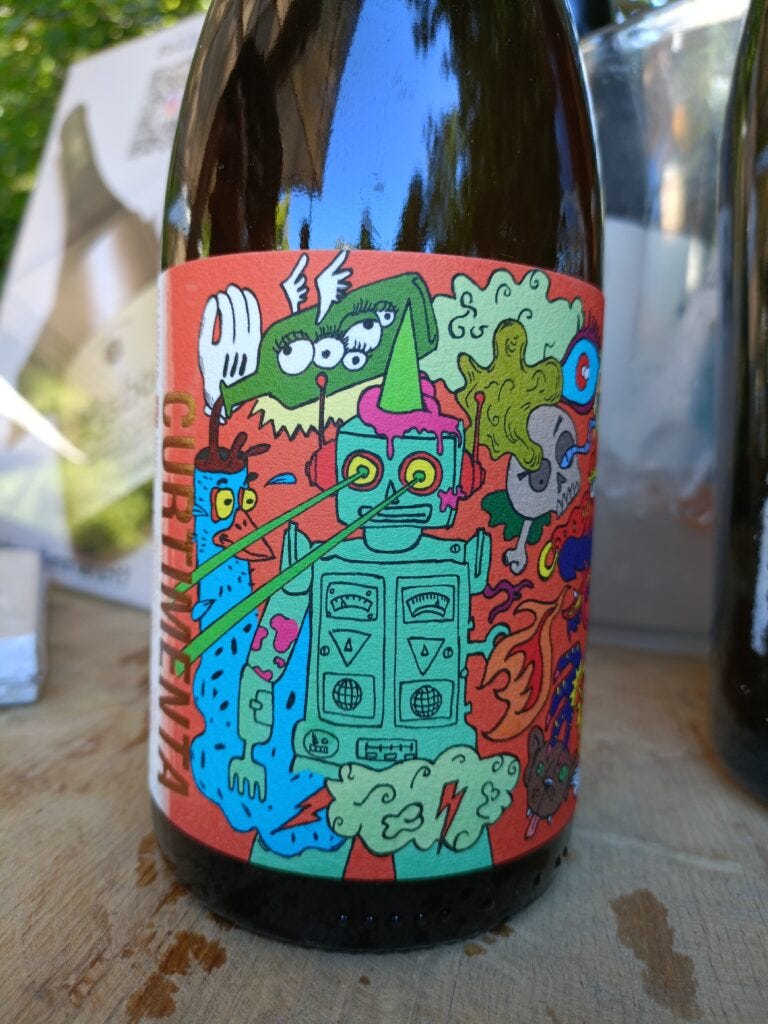
I've been tasting Hugo's wines for the last three years or so, and I think this is hands down his best Curtimenta (orange wine) so far. Arinto can be all things to all people, it grows pretty much everywhere in Portugal and gets pulled into service for just about everything. But here, Hugo has given it real personality and made a success out of a whopping six months' skin contact. It feels energetic with a grassy, citrus charge and plenty of herbal, earthiness to lend depth. The texture is soft (surprisingly!) but with a feeling of body. I enjoyed a fleeting hint of sourness on the finish, which left my mouth feeling fresh. I also admit to loving the label. I do seem to have a thing for slightly brash, colourful labels.... Price and availability: €20 - €27 in Portugal, £26.50 in the UK. See wine-searcher.com for details.
Quinta do Javali - Clos Fonte do Santo 2018 Cherry Tree Vineyard (Douro, Portugal)
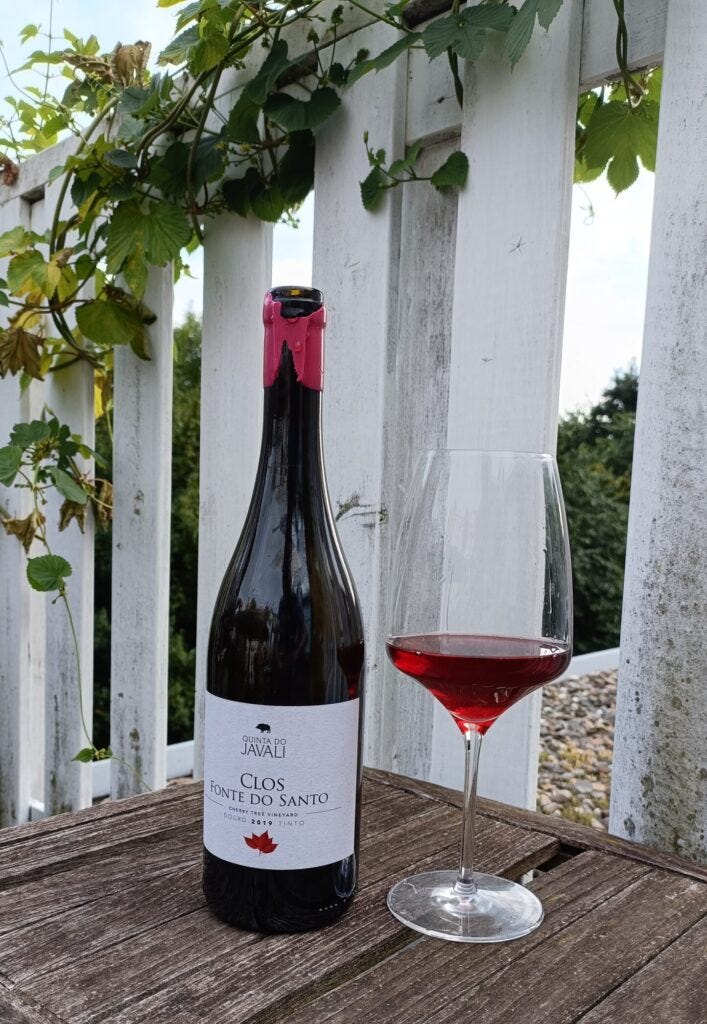
When I started tasting António Mendes Jr's single vineyard Douro reds, they made no sense. How could this light coloured, elegant wine with only 12% ABV come from the hot Cima Corga - the fiery furnace of a sub-region at the heart of the Douro? I asked António and he gave an answer that was so simple that it floored me. "This vineyard is north facing". What would have been seen as a curse half a century ago is now a blessing - at least if you want to make the refined, fruit forward style that António and his family prefer. Clos Fonte do Santo is planted with a traditional field blend (Tinta Roriz, Touriga Franca, Tinto Cão, Touriga Nacional, Tinta Barroca and Sousão), and the wine is wild fermented before ageing in used barrels. I love the fact that there is no discernable oak influence in these wines, just the soft caress of ripe red fruits, Touriga's signature violet perfume and a fine, schisty, texture to the tannins. Price and availability: Around €30, widely available in Europe, the US and beyond.
Mimo – Velo de Flor 2018 (Valle de Ica, Peru)
I initially tasted a bottle of this Peruvian wine in Amsterdam at the beginning of the year. Then in the summer, its co-creator Pepe Moquillaza showed up in my hometown (en route to a wine fair in Italy) and we got to sit down and share lunch. Even better, he gave me another bottle of the wine, which proved just as delicious as the first. This wine was revelatory to me for its freshness - not a given with most of the Criolla varieties and the few other Peruvian natural wines I've tried. The blend is Albilla with some Moscatel, left on its skins for five months and then aged in large format barrels – where it developed a layer of flor yeast. The nose has an enticing character of citrus essential oils and grapefruit pith. The flor influence is subtly and doesn't stray into sherry territory. Rather, it just seems to turbo-charge the aromatics. The vineyards are at about 400 meters above sea level, with sandy soils and a very dry climate. Read my full tasting note here. Price and availability: difficult. Pepe is working on wider distribution but so far the wine is not available in Europe. I hope this will be rectified soon.
Domaine Guillemot-Michel, Viré-Clessé Quintaine 2014 (Macon, France)
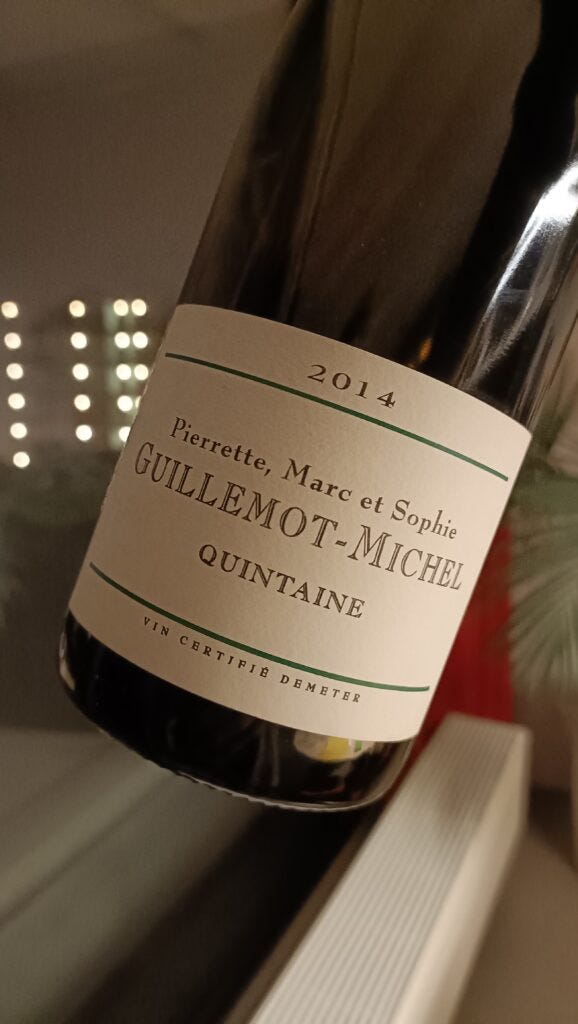
How I got this bottle remains a mystery. Did I buy it? I don't think so. Did someone give it to me? (If it was you, please let me know). I looked at it in the rack and thought, oops. Eight year old white Burgundy... that might be dead already. I mean, pre-mox? Knowing nothing about the domaine, I uncorked it with a good friend and it turned out to be blinding. Perfectly mature Chardonnay, with that seductive creamy texture and deeply nuanced palate. Some notes of fresh tarragon and other herbs, very subtle hints at the evolution and the age but there are years more of potential here. And all accomplished with zero oak at all. The estate converted to organic farming in the 1980s and was Demeter certified in 1992. Fermentations are natural, and this wine was fermented in concrete tanks and then aged on the lees (but not in wood). The Macon (in which this appellation is contained) is one of few remaining parts of Burgundy where there is any kind of value to be had. And this is serious value. I would be perfectly happy if someone told me this was Puligny-Montrachet. A final note: A glass and a half of this bottle sat in my fridge for three days after I'd opened the bottle. Scandalous I know. But it was even better, richer and more complex when I finally got to it. Price and availability: £24 from The Wine Society in the UK. Widely available across Europe for €22 - €30, see wine-searcher.com


